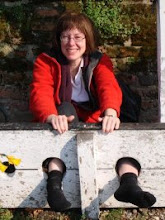Here is a quilt that I bought last month - it is a nicely made North Country Strippy. These were the "everyday" quilts - and many were made as "Club" quilts, where for a subscription of a shilling or two over twenty weeks, you had a quilt made for you by a local quilter. It was a good way to afford what was an expensive purchase, while supporting a local woman and her family. Many women had little to live on after mine accidents or other calamities.
This quilt is nicely stitched and is better made than many; many have sparse stitching, as the quilts had to be produced in little over a week. Strippy colours are often red and white or blue and white - this one is made with a pale pink and a tan or beige cloth. the colours in the last photograph are the most realistic.
A closer look at the quilting patterns, which follow the strips, as is usual. There is a running feather, a rose in a square, and a fancy twist pattern.
The edges are, of course, finished with a knife or butt edge. Many of you may remember "the edge" that Pauline Adams discovered where one edge is seamed together before the quilt is put in the frame. This treatment, though unrecorded in the literature, seems to have been surprisingly common. Both of my Hawick quilts have this treatment, as does this quilt. You might be able to see that the two edges look different in the photo. The lower one is where the edges have been seamed together. There is no need for a line of machine stitching, and the wadding does not really reach the edge. This method made it easier for the quilter, as one edge was already complete and did not have to be finished off. It also was economical of cloth and made it easier to put the quilt in the frame.
A nice Durham quilt for the collection - I took it to a pensioners' group in Felixstowe yesterday afternoon, where it and the other quilts were much admired. A few had memories of quilts, but most did not, as East Anglia has no tradition of quilts. Eiderdowns seem to have been the usual bed covering here.
An extra 15 or 20 people (non-members) had turned out, so quilts obviously touch a nerve at the moment, and are of interest. I was also closely questioned about my bookkeeping work by some parents whose daughter wants to change career! I think many people worry about finding sufficient work at the moment.






A beautiful quilt with beautiful quilting patterns. I haven't seen a twist like this one before, interesting! And I am happy that experts like you collect all these great quilts and examples of a traditional craft and prevent them from distruction. Thank you!
ReplyDelete